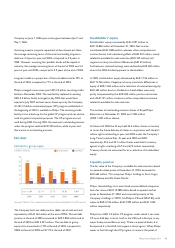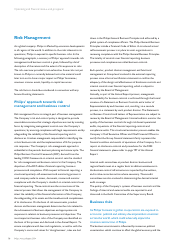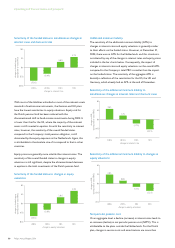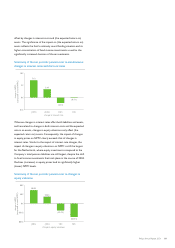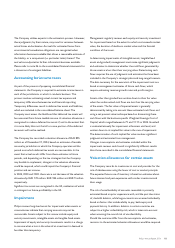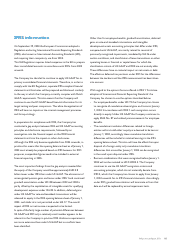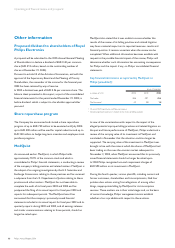Philips 2004 Annual Report Download - page 84
Download and view the complete annual report
Please find page 84 of the 2004 Philips annual report below. You can navigate through the pages in the report by either clicking on the pages listed below, or by using the keyword search tool below to find specific information within the annual report.The Company utilizes experts in the estimation process. However,
these judgments, by their nature, may result in variances between
actual losses and estimates. Accruals for estimated losses from
environmental remediation obligations are recognized when
information becomes available that allows a reasonable estimate of
the liability, or a component (i.e. particular tasks) thereof. The
accruals are adjusted as further information becomes available.
Please refer to note 26 to the consolidated financial statements for
a discussion of contingent liabilities.
Accounting for income taxes
As part of the process of preparing consolidated financial
statements, the Company is required to estimate income taxes in
each of the jurisdictions in which it conducts business. This
process involves estimating actual current tax expense and
temporary differences between tax and financial reporting.
Temporary differences result in deferred tax assets and liabilities,
which are included in the consolidated balance sheet. The
Company must assess the likelihood that deferred tax assets will
be recovered from future taxable income. A valuation allowance is
recognized to reduce deferred tax assets if, and to the extent that,
it is more likely than not that all or some portion of the deferred
tax assets will not be realized.
The Company has recorded a valuation allowance of EUR 895
million as of December 31, 2004, based on estimates of taxable
income by jurisdiction in which the Company operates and the
period over which deferred tax assets are recoverable. In the
event that actual results differ from these estimates in future
periods, and depending on the tax strategies that the Company
may be able to implement, changes to the valuation allowance
could be required, which could impact the Company’s financial
position and net income.
In 2004, 2003 and 2002, there was a net decrease of the valuation
allowance by EUR 170 million, EUR 184 million and EUR 9 million
respectively.
Significant tax assets are recognized in the US, realization of which
is contingent on future profitability in the US.
Impairment
Philips reviews long-lived assets for impairment when events or
circumstances indicate that carrying amounts may not be
recoverable. Assets subject to this review include equity and
security investments, intangible assets and tangible fixed assets.
Impairment of equity and security investments results in a charge
to income when a loss in the value of an investment is deemed to
be other than temporary.
Management regularly reviews each equity and security investment
for impairment based on the extent to which cost exceeds market
value, the duration of decline in market value and the financial
condition of the issuer.
In determining impairments of intangible assets, tangible fixed
assets and goodwill, management must make significant judgments
and estimates to determine whether the cash flows generated by
those assets are less than their carrying value. Determining cash
flows requires the use of judgments and estimates that have been
included in the Company’s strategic plans and long-range forecasts.
The data necessary for the execution of the impairment tests are
based on management estimates of future cash flows, which
require estimating revenue growth rates and profit margins.
Assets other than goodwill are written down to their fair value
when the undiscounted cash flows are less than the carrying value
of the assets. The fair value of impaired assets is generally
determined by taking into account these estimated cash flows and
using a net present value technique based on discounting these
cash flows with the business-specific Weighted Average Cost of
Capital, which ranged between 6.7% and 12.1% in 2004. Goodwill
is evaluated annually for impairment at business unit level, and
written down to its implied fair value in the case of impairment.
The determination of such implied fair value involves significant
judgment and estimates from management.
Changes in assumptions and estimates included within the
impairment reviews could result in significantly different results
than those recorded in the consolidated financial statements.
Valuation allowances for certain assets
The Company records its inventories at cost and provides for the
risk of obsolescence using the lower of cost or market principle.
The expected future use of inventory is based on estimates about
future demand and past experience with similar inventories and
their usage.
The risk of uncollectibility of accounts receivable is primarily
estimated based on prior experience with, and the past due status
of, doubtful debtors, while large accounts are assessed individually
based on factors that include ability to pay, bankruptcy and
payment history. In addition, debtors in certain countries are
subject to a higher collectibility risk, which is taken into account
when assessing the overall risk of uncollectibility.
Should the outcome differ from the assumptions and estimates,
revisions to the estimated valuation allowances would be required.
83Philips Annual Report 2004


